Mid-Range to High-End Buyer's Guide, January 2006
by Jarred Walton on January 2, 2006 1:00 AM EST- Posted in
- Guides
Remaining Recommendations
The majority of the remaining parts all have a lesser impact on performance, and for several areas, you can just get whatever is cheapest. A low cost case might have sharp edges inside, and a low cost PSU might be noisy or fail prematurely - particularly if you load up the system with higher end components - but otherwise, there isn't a huge difference between the remaining components other than prices. Since we're giving Mid-Range and High-End configurations, we will be spending quite a bit more on the latter for what some may feel are unimportant aspects of a computer system. The Z-5500 speakers, for example, are overkill if you're living in an apartment or small house. For that matter, even the Z-2300 speakers are more than what many users will need. More than any of the other recommendations, there is a lot of subjective opinion in picking out these remaining items. If you don't want powerful speakers, save the money. If sound quality is important - which is our assumption on the High-End platform - you will probably want good speakers as well as a discrete sound card. If you're happy with a cheap case, you can cut costs there as well. Here are our guidelines for the remaining components.
The only two areas where it's really worth upgrading to something more than the above choices are storage and the power supply. If you're planning on running multiple GPUs with multiple hard drives, the 400W SmartPower 2.0 in the Mid-Range system may prove insufficient. The ePOWER/Tagan in the High-End system is more than enough for almost any use, though there are quite a few alternatives with a similar price. Fotron Source, Antec, Enermax, Seasonic, OCZ, and several other companies make PSUs worth considering, but we like the modular design, SLI support, and general high-quality of the Tagan unit. $120 is a lot to pay for a power supply, but then we'd even take it one step further and recommend picking up a UPS to go with the computer. $100 will get a good quality UPS that will help prevent loss of data from anything ranging from a power outage to an electrical surge.
The hard drives both ended up being from Western Digital, with the only upgrade on the High-End component being the move to a 16MB cache model. 250GB of storage and 3.0Gbps transfer rates are plenty for the vast majority of users. You could even drop down to a 160GB or even 80GB HDD if you don't need the storage, though the cost per GB on the 250GB drives is the lowest of any of the models. If you store lots of music, movies, photos, etc. on your system, though, you might want to go the other way and look for more storage capacity. Seagate's 300GB and larger 7200.9 drives can be found with 16MB of cache for the ultimate in capacity and performance, but prices are quite high. Some people still swear by the faster access times of the WD Raptor drives, but personally, I would add more RAM before worrying about spending $150 for a 74GB drive. If you want some data reliability, some motherboards are even shipping with integrated RAID 5 controllers: use 3 or 4 HDDs and you can get over a TB of storage and still be protected from data loss as long as no more than one drive fails. That's really more low-end server/high-end workstation stuff, however, so we'll stick with a single 250GB drive for now.
The majority of the remaining parts all have a lesser impact on performance, and for several areas, you can just get whatever is cheapest. A low cost case might have sharp edges inside, and a low cost PSU might be noisy or fail prematurely - particularly if you load up the system with higher end components - but otherwise, there isn't a huge difference between the remaining components other than prices. Since we're giving Mid-Range and High-End configurations, we will be spending quite a bit more on the latter for what some may feel are unimportant aspects of a computer system. The Z-5500 speakers, for example, are overkill if you're living in an apartment or small house. For that matter, even the Z-2300 speakers are more than what many users will need. More than any of the other recommendations, there is a lot of subjective opinion in picking out these remaining items. If you don't want powerful speakers, save the money. If sound quality is important - which is our assumption on the High-End platform - you will probably want good speakers as well as a discrete sound card. If you're happy with a cheap case, you can cut costs there as well. Here are our guidelines for the remaining components.
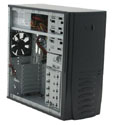 |
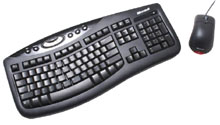 |
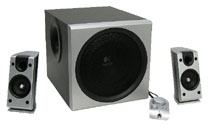 |
| Click images to enlarge. | ||
| Mid-Range Components | ||
| Hard Drive | Western Digital 3.0Gbps 250GB 7200RPM 8MB Caviar SE | 99 |
| Optical Drive | BenQ DVDR DQ60 (OEM) | 41 |
| Case and Power Supply | Antec Solution SLK3800B + 400W SmartPower 2.0 | 116 |
| Speakers | Logitech Z-2300 2.1 | 112 |
| Keyboard and Mouse | Microsoft Comfort Curve 2000 + Optical Mouse | 30 |
| Total | 398 | |
 |
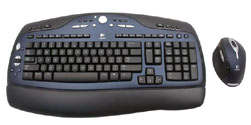 |
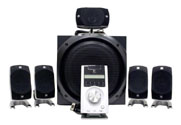 |
| Click images to enlarge. | ||
| High-End Components | ||
| Hard Drive | Western Digital 3.0Gbps 250GB 7200RPM 16MB Caviar SE16 | 115 |
| Optical Drive | NEC DVDR ND-3550A | 43 |
| Case | Lian Li PC-6077B Aluminum | 138 |
| Power Supply | ePOWER/Tagan TG-530-U15 530W | 120 |
| Sound Card | Creative Sound Blaster Audigy 2 ZS | 73 |
| Speakers | Logitech Z-5500 5.1 w/Dolby Digital | 253 |
| Keyboard and Mouse | Logitech Cordless Desktop MX3100 (Laser tracking mouse) | 95 |
| Total | 837 | |
The only two areas where it's really worth upgrading to something more than the above choices are storage and the power supply. If you're planning on running multiple GPUs with multiple hard drives, the 400W SmartPower 2.0 in the Mid-Range system may prove insufficient. The ePOWER/Tagan in the High-End system is more than enough for almost any use, though there are quite a few alternatives with a similar price. Fotron Source, Antec, Enermax, Seasonic, OCZ, and several other companies make PSUs worth considering, but we like the modular design, SLI support, and general high-quality of the Tagan unit. $120 is a lot to pay for a power supply, but then we'd even take it one step further and recommend picking up a UPS to go with the computer. $100 will get a good quality UPS that will help prevent loss of data from anything ranging from a power outage to an electrical surge.
The hard drives both ended up being from Western Digital, with the only upgrade on the High-End component being the move to a 16MB cache model. 250GB of storage and 3.0Gbps transfer rates are plenty for the vast majority of users. You could even drop down to a 160GB or even 80GB HDD if you don't need the storage, though the cost per GB on the 250GB drives is the lowest of any of the models. If you store lots of music, movies, photos, etc. on your system, though, you might want to go the other way and look for more storage capacity. Seagate's 300GB and larger 7200.9 drives can be found with 16MB of cache for the ultimate in capacity and performance, but prices are quite high. Some people still swear by the faster access times of the WD Raptor drives, but personally, I would add more RAM before worrying about spending $150 for a 74GB drive. If you want some data reliability, some motherboards are even shipping with integrated RAID 5 controllers: use 3 or 4 HDDs and you can get over a TB of storage and still be protected from data loss as long as no more than one drive fails. That's really more low-end server/high-end workstation stuff, however, so we'll stick with a single 250GB drive for now.










67 Comments
View All Comments
Yawgm0th - Monday, January 2, 2006 - link
Why restrict the display choices to LCDs that can't handle 1600x1200 and then complain about Crossfire only being able to support 1600x1200@60Hz. If you're willing to and would prefer to use an LCD, then how can you justify complaining about a shortcoming of Crossfire that can't possibly bother you?I'm not in favor of Crossfire or even opposed to LCDs (though I certainly prefer CRTs when mobility is not needed), but it would be nice to have some consistency.
JarredWalton - Monday, January 2, 2006 - link
As I suggested, Crossfire is a high-end option, and my high-end display choice is definitely going to want the new X1800 CF and not the X800 variant. I don't recommend SLI *or* Crossfire for a Mid-range system. I mean, $400-$500 gets you an X800 CF setup or a 6800GS SLI setup... or you can just get a single 7800GTX or X1800XT. Then you don't need to worry about CF/SLI profiles, improperly optimized games, etc. and you can always add a second card later if you change your mind.ImJacksAmygdala - Monday, January 2, 2006 - link
If I'm going to spend >$300 on a new monitor I atleast want it to be future proof with HDCP...JarredWalton - Monday, January 2, 2006 - link
THere is no way Microsoft or anyone else is going to force HDCP on us with Vista. Quick, name all the HDCP compliant displays out on the market. Um, there aren't any, at least outside of the HDTV world, right? MS knows that ALL of the market currently runs non-HDCP displays, so they would be completely insane to require everyone to buy a new monitor.DigitalFreak - Monday, January 2, 2006 - link
Wait a couple more weeks, and you can get the Dell 3007. 30" widescreen with specs comparable to the Apple 30" cinema display. No word on price yet, but I'm betting it will be quite a bit less than the Apple.JarredWalton - Monday, January 2, 2006 - link
There's also the 2407FPW coming out soon. I imagine the 30" display will be firmly in the "Dream" category, but I'm curious to see where the 2407 gets priced. It should be a bit cheaper than the 2405 to manufacture, but with higher specs it could still end up costing significantly more.Pythias - Monday, January 2, 2006 - link
I know you folks mean well, but cut the guy a little slack or else write your own guide.I believe the purpose of this article and its predecessors is to offer suggestions for people who have difficulty choosing components.
As Jarred said, This guide is not written in stone. Rather, it is merely a template subject to the individual's discretion.
tomchae - Monday, January 2, 2006 - link
these had the best feedback in newegg. are these good?-ABIT KN8 Ultra Socket 939 NVIDIA nForce4 Ultra ATX AMD Motherboard $99
http://www.newegg.com/Product/Product.asp?Item=N82...">http://www.newegg.com/Product/Product.asp?Item=N82...
-ASUS A8N-SLI Socket 939 NVIDIA nForce4 SLI ATX AMD Motherboard $122
http://www.newegg.com/Product/CustratingReview.asp...">http://www.newegg.com/Product/CustratingReview.asp...
bob661 - Monday, January 2, 2006 - link
I can definitely recommend the Asus board. Rock solid.JarredWalton - Tuesday, January 3, 2006 - link
Honestly, these days it's easier to come up with a short list of motherboards I *wouldn't* buy rather than ones that stand out as exceptional - and that goes double for socket 939 boards. There are very few boards out there that I would absolutely avoid. I just cut off my "alternative" list at a few boards from each price range; there are plenty of others (including ASUS, MSI, EPoX, Abit, etc.) that will work well.